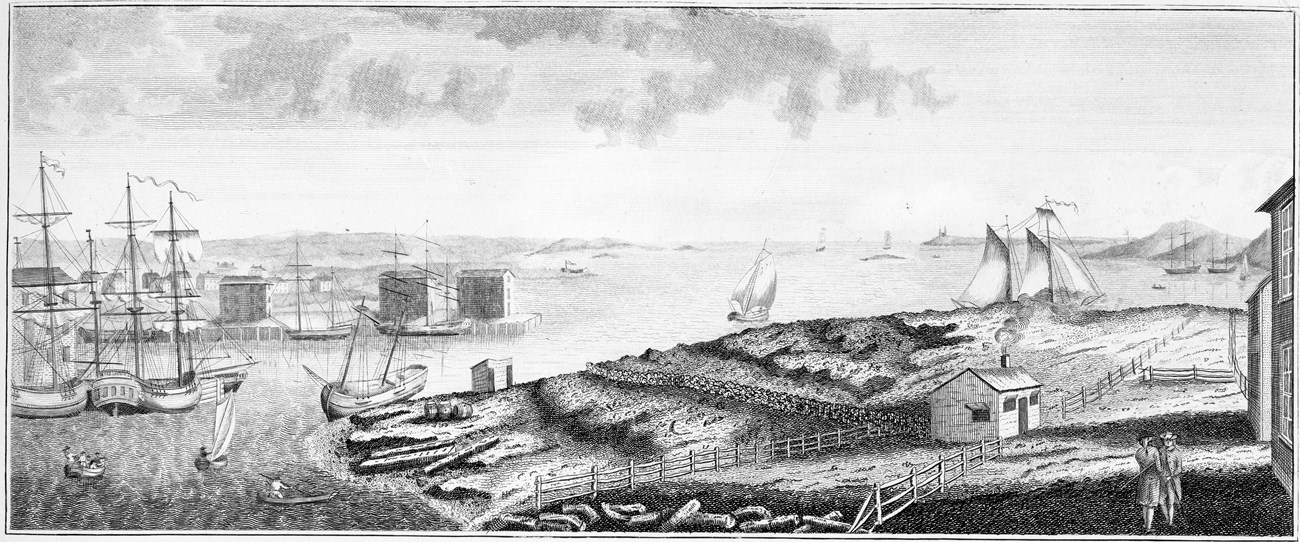Last updated: August 11, 2021
Article
Salem Marine Society Certificate
The Salem Marine Society was founded in 1766 by a group of captains from Salem and Beverly. Its purpose was to provide assistance to members if they became ill or met with other difficulties and to assist the widows of deceased members.
In addition, the Salem Marine Society encouraged mapping of the coastline in order to improve local navigation. In the 1790s, they sponsored the placement of buoys in Salem Harbor, and the construction of a beacon on Baker's Island, thus improving the safety of vessels in the harbor. Still in existence today and made up of the descendants of its seafaring founders, the Salem Marine Society continues its charitable mission.

NPS Photo
Abjiah Northey, Membership Certificate for the Salem Marine Society, 1797
American
Ink on paper
Transferred from U. S. Treasury Department, SAMA 2520
The certificate of membership was designed by Abijiah Northey, Jr. in 1797, and depicts scenes that would have been very familiar to Salem captains: a view of Salem Harbor, lightering, launch, breaming, and screwing fish.
Salem Harbor

NPS Photo
The image at the top of the Salem Marine Society membership certificate is one of the earliest depictions of Salem Harbor. The view is from the shipyard of Enos Briggs at Stage Point, across the South River and towards the Atlantic Ocean. Derby Wharf, with its three tall warehouses, is in the center of the image, while in the foreground are the flakes or stages where codfish would be dried before being packed in barrels of salt. On the horizon is the new lighthouse on Baker's Island. This lighthouse was built in 1797 to replace the Salem Marine Society's unlighted beacon.

NPS Photo
Lightering
In this scene, a coastal schooner is waiting off shore while cargo is unloaded from a small rowboat, or lighter, onto a horse-drawn cart. This process of transferring cargo between vessels of different sizes is known as lightering.
Schooners like this one, with a crew of approximately five men, carried cargo up and down the coast of the United States and into the Caribbean.
Many of the small coastal communities the schooners traded with had no wharves, so lightering cargo to shore was a common way to unload or take on cargo.

NPS Photo
Launch
This image depicts a small brig being launched from a shipyard. The launch of a vessel was usually a public event, as can be seen by the crowd on land. There are also people riding on the deck as the vessel slides down the ways and into the water for the first time.
Once the vessel is in the water and floating, the next step is to add the rigging and sails. Then, the brig will be ready to be loaded with cargo and set out on her first voyage.

NPS Photo
Breaming
Here, a large vessel, probably a brig, has been careened on shore for breaming. There were few dry docks in the eighteenth century. If work needed to be done on the hull of a ship, the easiest way to do it was to drag the vessel ashore and roll it on its side. This was called careening.
Breaming was a way to remove growths like seaweed, barnacles, and other items picked up by a vessel in its travels. Fire was used to soften the tar in the hull so that growths could be easily scraped or swept off. With a smooth, clean hull, the vessel could sail faster.

NPS Photo
Screwing Fish
This scene depicts the process known as screwing fish. Salted codfish were packed tightly into strong barrels with the help of a screw press.
The tremendous amount of pressure that could be created by the press can be seen from the huge beams that hold the screw, and the number of thick hoops holding the barrel together.
Cod was dried or cured using salt to preserve it for a long period of time. Dried and salted cod became the basis of New England’s economy for more than 200 years.

NPS Photo
Membership
Membership in the Salem Marine Society was initially open only to captains, then extended to ship owners in 1790. When a gentleman was accepted as a member, the certificate would be filled out with his membership number, name, and date, then signed by the Secretary and Master of the society. Finally, a red wax seal would be fixed to the bottom of the certificate.
Members would pay dues, and were fined for such offences as quarreling with other members, using foul language in a meeting, or missing a meeting. The fines and dues would be kept by the society and used for their charitable or navigational activities.
